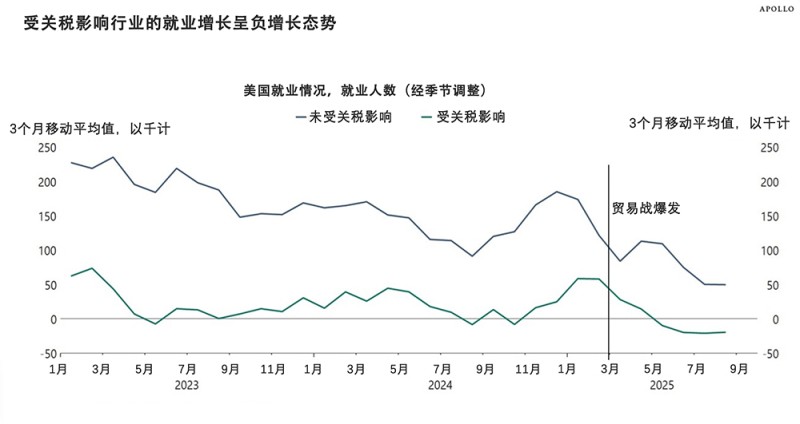
• 8月惨淡的就业报告证实,劳动力市场在春夏两季显著降温,而这恰逢唐纳德·特朗普发动贸易战之时。尽管部分受关税影响行业的就业人数变动不大,但制造业、批发贸易等行业却遭受沉重打击。
自唐纳德·特朗普今年年初发动贸易战以来,受关税影响行业已裁减数万个工作岗位。
最新就业报告显示,8月美国经济仅新增2.2万个就业岗位,且此前数月的数据经修正后显示,6月实际就业岗位有所减少。与此同时,失业率小幅攀升至四年高点4.3%。
阿波罗全球管理公司(Apollo Global Management)首席经济学家托尔斯滕·斯洛克 (Torsten Sløk)在上周六发布的报告中指出,受关税影响行业的就业增长呈负增长态势,而未受关税影响的行业虽增速放缓,但仍保持正增长。
特朗普时断时续的关税政策使得这场贸易战的确切起始时间难以界定。今年2月,特朗普签署行政令,对加拿大、墨西哥和中国加征关税,但将针对加墨两国的关税推迟至3月实施。
4月,他宣布对几乎所有国家征收“解放日”关税,但在市场崩盘一周后暂停了该计划。此后,特朗普与多个贸易伙伴达成协议,而与中国的谈判仍在持续。然而,对于90多个未能达成此类协议的国家,所谓的“对等关税”已于8月生效,不过该政策也面临着重大法律挑战。
斯洛克将3月视为贸易战的开端,并指出受关税影响的行业包括制造业、采矿与伐木业、建筑业、批发贸易、零售贸易、交通运输业以及仓储业。

依据这一时间线及上述行业分类,对美国劳工统计局的数据进行深入研究,便能揭示出经济中受冲击最严重的领域。
在所有受关税影响的行业中,自2月(贸易战爆发前最后一个月)以来,就业人数净减少9.01万人。相比之下,同期整体就业人数增长38.5万人,其中受关税影响较小的医疗保健和酒店业成为推动就业增长的“中流砥柱”。
但即便在受关税影响的行业内部,不同领域受冲击的程度也存在差异。例如,制造业减少了4.1万个工作岗位,批发贸易减少了3.4万个工作岗位。
而建筑业就业岗位基本保持不变,零售贸易甚至新增1.9万个工作岗位。采矿和伐木业虽减少1.6万个工作岗位,但该类别包含油气开采业——该领域受到原油价格下跌及欧佩克+为抢占市场份额而提高产量的双重冲击。
诚然,未直接受关税影响的行业也出现裁员,这在一定程度上源于贸易战引发的整体经济不确定性。
数月以来,裁员行业数量一直多于新增就业行业数量,穆迪分析(Moody’s Analytics)首席经济学家马克·赞迪(Mark Zandi)警告称,这种情况“只会在经济衰退时出现”。
特朗普政府坚称,其推行的减税和放松监管政策将刺激经济增长,关税政策最终将创造更多就业岗位,并鼓励企业加大国内生产投资。
在接受美国全国广播公司(NBC)《与媒体见面》节目主持人克里斯汀·韦尔克采访时,贝森特表示现行政策将创造优质高薪就业岗位。贝森特还称,历年8月采集的就业数据往往都会出现大幅修正的情况,并指责美联储未能更早实施降息举措。
“特朗普总统当选的核心要义在于推动变革,我们将推行能让经济重回正轨的政策。我相信到第四季度,我们将会看到经济增长大幅提速。”贝森特预测道。(*)
译者:中慧言-王芳
• 8月惨淡的就业报告证实,劳动力市场在春夏两季显著降温,而这恰逢唐纳德·特朗普发动贸易战之时。尽管部分受关税影响行业的就业人数变动不大,但制造业、批发贸易等行业却遭受沉重打击。
自唐纳德·特朗普今年年初发动贸易战以来,受关税影响行业已裁减数万个工作岗位。
最新就业报告显示,8月美国经济仅新增2.2万个就业岗位,且此前数月的数据经修正后显示,6月实际就业岗位有所减少。与此同时,失业率小幅攀升至四年高点4.3%。
阿波罗全球管理公司(Apollo Global Management)首席经济学家托尔斯滕·斯洛克 (Torsten Sløk)在上周六发布的报告中指出,受关税影响行业的就业增长呈负增长态势,而未受关税影响的行业虽增速放缓,但仍保持正增长。
特朗普时断时续的关税政策使得这场贸易战的确切起始时间难以界定。今年2月,特朗普签署行政令,对加拿大、墨西哥和中国加征关税,但将针对加墨两国的关税推迟至3月实施。
4月,他宣布对几乎所有国家征收“解放日”关税,但在市场崩盘一周后暂停了该计划。此后,特朗普与多个贸易伙伴达成协议,而与中国的谈判仍在持续。然而,对于90多个未能达成此类协议的国家,所谓的“对等关税”已于8月生效,不过该政策也面临着重大法律挑战。
斯洛克将3月视为贸易战的开端,并指出受关税影响的行业包括制造业、采矿与伐木业、建筑业、批发贸易、零售贸易、交通运输业以及仓储业。
依据这一时间线及上述行业分类,对美国劳工统计局的数据进行深入研究,便能揭示出经济中受冲击最严重的领域。
在所有受关税影响的行业中,自2月(贸易战爆发前最后一个月)以来,就业人数净减少9.01万人。相比之下,同期整体就业人数增长38.5万人,其中受关税影响较小的医疗保健和酒店业成为推动就业增长的“中流砥柱”。
但即便在受关税影响的行业内部,不同领域受冲击的程度也存在差异。例如,制造业减少了4.1万个工作岗位,批发贸易减少了3.4万个工作岗位。
而建筑业就业岗位基本保持不变,零售贸易甚至新增1.9万个工作岗位。采矿和伐木业虽减少1.6万个工作岗位,但该类别包含油气开采业——该领域受到原油价格下跌及欧佩克+为抢占市场份额而提高产量的双重冲击。
诚然,未直接受关税影响的行业也出现裁员,这在一定程度上源于贸易战引发的整体经济不确定性。
数月以来,裁员行业数量一直多于新增就业行业数量,穆迪分析(Moody’s Analytics)首席经济学家马克·赞迪(Mark Zandi)警告称,这种情况“只会在经济衰退时出现”。
特朗普政府坚称,其推行的减税和放松监管政策将刺激经济增长,关税政策最终将创造更多就业岗位,并鼓励企业加大国内生产投资。
在接受美国全国广播公司(NBC)《与媒体见面》节目主持人克里斯汀·韦尔克采访时,贝森特表示现行政策将创造优质高薪就业岗位。贝森特还称,历年8月采集的就业数据往往都会出现大幅修正的情况,并指责美联储未能更早实施降息举措。
“特朗普总统当选的核心要义在于推动变革,我们将推行能让经济重回正轨的政策。我相信到第四季度,我们将会看到经济增长大幅提速。”贝森特预测道。(*)
译者:中慧言-王芳
• The dismal August jobs report confirmed the labor market cooled significantly during the spring and summer. That coincided with the start of President Donald Trump’s trade war. While some tariff-impacted industries have seen minimal changes in payrolls, others like manufacturing and wholesale trade have taken bigger hits.
Since President Donald Trump launched his trade war earlier this year, industries impacted by tariffs have shed tens of thousands of jobs.
The latest jobs report revealed the U.S. economy added just 22,000 jobs in August with revisions to prior months showing June actually saw a decline. Meanwhile, the unemployment rate edged up to a four-year high of 4.3%.
In a note on Saturday, Torsten Sløk, chief economist at Apollo Global Management, observed job growth in tariff-impacted sectors is negative, while those not affected by tariffs have seen slower growth but remain in positive territory.
Trump’s on-again, off-again tariffs have made that pinning down the exact start of his trade war a bit tricky. In February, he signed an executive order to impose tariffs on Canada, Mexico and China, but put the ones on Canada and Mexico on hold until March.
In April, he unveiled his “Liberation Day” tariffs on nearly all countries, but put those on hold after a week amid a market crash. Since then, Trump has reached deals with several trading partners while talks with China continue. But for more than 90 countries without such deals, so-called reciprocal tariffs took effect in August, though they also face a major legal challenge.
For his part, Sløk sees March as the start of the trade war and listed manufacturing, mining and logging, construction, wholesales trade, retail trade, transportation, and warehousing as the industries impacted by tariffs.
Using that timeline and those sectors, a deep dive into Bureau of Labor Statistics data reveals which parts of the economy have been hurt the most.
Across all the tariff-impacted industries, payrolls fell by a net 90,100 after February—the last pre-trade war month. By contrast, payrolls overall grew by 385,000 during that span, as the health care and hospitality sectors, which are less affected by tariffs, have been the main drivers of job growth.
But even within tariff-impacted sectors, some areas have suffered more than others. For example, manufacturing shed 41,000 jobs, and wholesale trade lost 34,000.
But construction has been mostly flat, and retail trade even added 19,000 jobs. And while the mining and logging sector has lost 16,000 jobs, that category includes oil and gas extraction, which has been hit by lower crude prices and OPEC+ has ramped up production to grab market share.
To be sure, industries not directory affected by tariffs are cutting staff too, though that could be partly due to the general sense of economic uncertainty that the trade war has created.
For several months now, there have been more industries cutting jobs than adding them, a trend Moody’s Analytics chief economist Mark Zandi warned “only happens when the economy is in recession.”
The Trump administration has maintained that its tax cuts and deregulation will stoke more growth, with tariffs eventually creating more jobs and encouraging companies to invest in domestic production.
In an interview on NBC’s Meet the Press with Kristen Welker on Sunday, Treasury Secretary Scott Bessent said policies are in place that will create good, high-paying jobs. He also said payroll data collected in August has historically been prone to big revisions later, and he blamed the Federal Reserve for not cutting rates sooner.
“President Trump was elected for change, and we are going to push through with the economic policies that are going to set the economy right. I believe by the fourth quarter, we’re going to see a substantial acceleration,” Bessent predicted.

